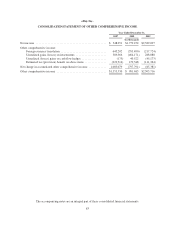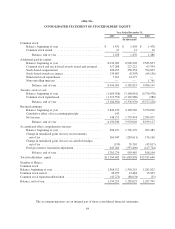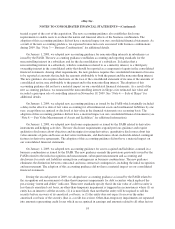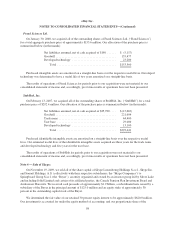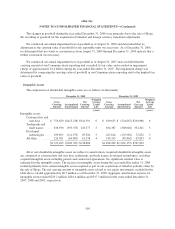eBay 2009 Annual Report Download - page 101
Download and view the complete annual report
Please find page 101 of the 2009 eBay annual report below. You can navigate through the pages in the report by either clicking on the pages listed below, or by using the keyword search tool below to find specific information within the annual report.eBay Inc.
NOTES TO CONSOLIDATED FINANCIAL STATEMENTS—(Continued)
treated as part of the cost of the acquisition. The new accounting guidance also establishes disclosure
requirements to enable users to evaluate the nature and financial effects of the business combination. The
adoption of this accounting guidance did not have a material impact on our consolidated financial statements. As
a result of the new accounting guidance, we expensed transaction costs associated with business combinations
during 2009. See “Note 3 — Business Combinations” for additional details.
On January 1, 2009, we adopted new accounting guidance for noncontrolling interests in subsidiaries as
issued by the FASB. The new accounting guidance establishes accounting and reporting standards for the
noncontrolling interest in a subsidiary and for the deconsolidation of a subsidiary. It clarifies that a
noncontrolling interest in a subsidiary, which is sometimes referred to as a minority interest, is a third-party
ownership interest in the consolidated entity that should be reported as a component of equity in the consolidated
financial statements. Among other requirements, the new guidance requires the consolidated statement of income
to be reported at amounts that include the amounts attributable to both the parent and the noncontrolling interest.
The new guidance also requires disclosure on the face of the consolidated statement of income of the amounts of
consolidated net income attributable to the parent and to the noncontrolling interest. The adoption of this
accounting guidance did not have a material impact on our consolidated financial statements. As a result of the
new accounting guidance, we remeasured the noncontrolling interest in Skype at its estimated fair value and
recorded a gain upon sale of controlling interest on November 19, 2009. See “Note 4 — Sale of Skype” for
additional details.
On January 1, 2009, we adopted new accounting guidance as issued by the FASB which originally included
a delay in the effective date of fair value accounting for all nonfinancial assets and nonfinancial liabilities by one
year, except those recognized or disclosed at fair value in the financial statements on a recurring basis. The
adoption of this accounting guidance did not have a material impact on our consolidated financial statements (see
“Note 8 — Fair Value Measurement of Assets and Liabilities” for additional information).
On January 1, 2009, we adopted new disclosure requirements as issued by the FASB related to derivative
instruments and hedging activities. The new disclosure requirements expand previous guidance and require
qualitative disclosures about objectives and strategies for using derivatives, quantitative disclosures about fair
value amounts of gains and losses on derivative instruments, and disclosures about credit-risk-related contingent
features in derivative agreements. The adoption of this accounting guidance did not have a material impact on
our consolidated financial statements.
On January 1, 2009, we adopted new accounting guidance for assets acquired and liabilities assumed in a
business combination as issued by the FASB. The new guidance amends the provisions previously issued by the
FASB related to the initial recognition and measurement, subsequent measurement and accounting and
disclosures for assets and liabilities arising from contingencies in business combinations. The new guidance
eliminates the distinction between contractual and non-contractual contingencies, including the initial recognition
and measurement. The adoption of this accounting guidance did not have a material impact on our consolidated
financial statements.
During the second quarter of 2009, we adopted new accounting guidance as issued by the FASB related to
the recognition and measurement of other-than-temporary impairments for debt securities which replaced the
pre-existing “intent and ability” indicator. These new standards specify that if the fair value of a debt security is
less than its amortized cost basis, an other-than-temporary impairment is triggered in circumstances where (1) an
entity has an intent to sell the security, (2) it is more likely than not that the entity will be required to sell the
security before recovery of its amortized cost basis, or (3) the entity does not expect to recover the entire
amortized cost basis of the security (that is, a credit loss exists). Other-than-temporary impairments are separated
into amounts representing credit losses which are recognized in earnings and amounts related to all other factors
93


